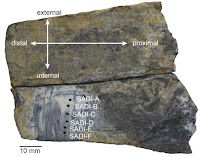Gomphotheres were Elephant-like Proboscidean Mammals that appeared in Eurasia in the Early Miocene, and reached North America (where they achieved their maximum diversity) by the Middle Miocene and South America in the Pliocene. Gomphotheres differed from modern ('True') Elephants in that they typically had four tusks, with the lower pair often modified into a shovel-like arrangement. Their teeth were distinctive from those of Elephants, and their diet is likely also to have been different, though what this was has not been completely resolved. Isotopic studies have suggested that Gomphotheres ate a diet rich in Grasses, while wear patterns on teeth have been interpreted as indicative of a diet rich in tough, woody material. Gomphotheres persisted till the Late Pleistocene (or possibly early Holocene) in South America and southern North America, with the last known remains associated with early archaeological sites.
In a paper published in the Journal of Paleontology on 4 June 2015, Bruce MacFadden of the Florida Museum of Natural History at the University of Florida, Gary Morgan of the New Mexico Museum of Natural History and Science, and Douglas Jones and Aldo Rincon, also of the Florida Museum of Natural History describe a partial Gomphothere tooth from the Miocene of Panama in southern Central America.
The tooth was discovered in 1959 by John Turner, then a pupil at Balboa High School in the former Canal Zone, close to the Madden Boy Scout Camp on Lake Madden (now lake Alajuela) and was shown to Bruce MacFadden at a Panama Canal Society meeting in Orlando, Florida, in July 2013. Subsequent investigation of the site suggests that it is Middle-to-Late Miocene in age, making it the oldest known Gomphothere tooth from Panama and the most southerly known Gomphothere tooth from the Miocene of the Americas.
MacFadden et al. assign the specimen to the genus Gomphotherium, but not to a specific species due to the fragmentary nature of the specimen, and note that there are an overabundance of Gomphotherium species described from North America, many from extremely fragmentary specimens, many of which cannot be reliably considered to be valid.
See also...
 Dating a Pleistocene Stegodon from West Timor. Stegodons were small members of the Elephant order Proboscidea known
from the Miocene-Pleistocene of Africa, Asia and North America. The last
members of the group were found in Southeast Asia and the islands of
Indonesia in the Late Pleistocene, where they...
Dating a Pleistocene Stegodon from West Timor. Stegodons were small members of the Elephant order Proboscidea known
from the Miocene-Pleistocene of Africa, Asia and North America. The last
members of the group were found in Southeast Asia and the islands of
Indonesia in the Late Pleistocene, where they...
 X-ray Computed Tomography studies of two Woolly Mammoth calves from Russia. The Woolly Mammoth, Mammuthus
primigenius, is thought to have diverged from the earlier Steppe Mammoth Mammuthus trogontherii in northeast...
X-ray Computed Tomography studies of two Woolly Mammoth calves from Russia. The Woolly Mammoth, Mammuthus
primigenius, is thought to have diverged from the earlier Steppe Mammoth Mammuthus trogontherii in northeast...
Gomphotherium sp., from the Alajuela Formation, Lake Alajuela, Panama Province Panama. (1) occlusal view; (2) occlusal view of cast; (3) labial (external) view; (4) lingual (internal) view. Red dots on the cast (2) represent measurement landmarks. These measurements represent the anterior-posterior length from the posterior-most part of the crown to the anterior border of the third pretrite trefoil and the greatest transverse width across the third lophid. Abbreviations: 2po, 2nd postrite cusp; 3pr, 3rd pretrite trefoil; 3po, 3rd postrite cusp; 4pr, 4th pretrite trefoil; 4po, 4 postrite cusp; hyp, hypoconulid; tre, trefoil. MacFadden et al. (2015).
MacFadden et al. assign the specimen to the genus Gomphotherium, but not to a specific species due to the fragmentary nature of the specimen, and note that there are an overabundance of Gomphotherium species described from North America, many from extremely fragmentary specimens, many of which cannot be reliably considered to be valid.
Map showing fossil collecting location, the now defunct Madden Boy Scout Camp, Lake Alajuela, Panama Province, Panama. MacFadden et al. (2015).
See also...
 Dating a Pleistocene Stegodon from West Timor. Stegodons were small members of the Elephant order Proboscidea known
from the Miocene-Pleistocene of Africa, Asia and North America. The last
members of the group were found in Southeast Asia and the islands of
Indonesia in the Late Pleistocene, where they...
Dating a Pleistocene Stegodon from West Timor. Stegodons were small members of the Elephant order Proboscidea known
from the Miocene-Pleistocene of Africa, Asia and North America. The last
members of the group were found in Southeast Asia and the islands of
Indonesia in the Late Pleistocene, where they... X-ray Computed Tomography studies of two Woolly Mammoth calves from Russia. The Woolly Mammoth, Mammuthus
primigenius, is thought to have diverged from the earlier Steppe Mammoth Mammuthus trogontherii in northeast...
X-ray Computed Tomography studies of two Woolly Mammoth calves from Russia. The Woolly Mammoth, Mammuthus
primigenius, is thought to have diverged from the earlier Steppe Mammoth Mammuthus trogontherii in northeast...
Fossil Dwarf Elephants are known from a number of small islands around
the world; this is not altogether surprising, dwarfism is common in
populations of animals cut of on small islands (as is giantism). Animals
in such environments often need to adapt to different niches to those
they inhabit on larger land-masses, but are able to do so due to lack of
competition, since there...
Follow Scieny Thoughts on Facebook.



